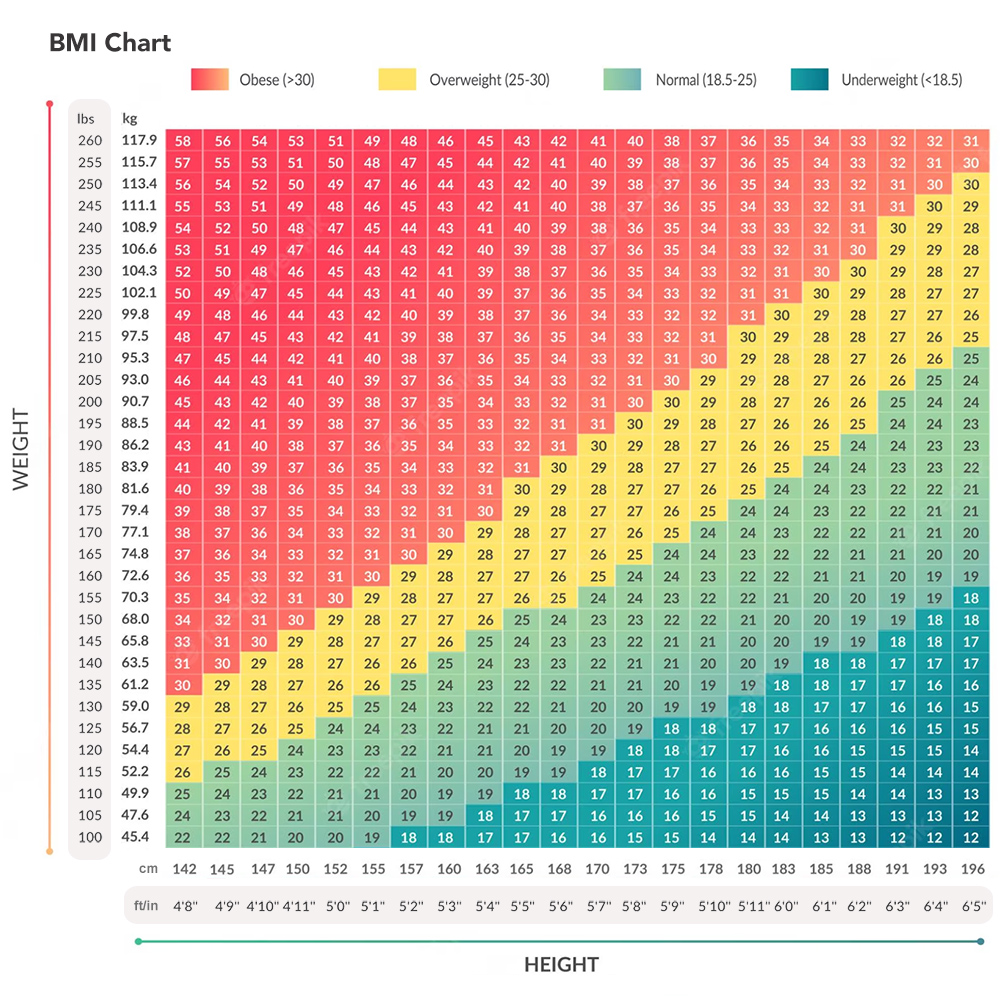BMI is a measure to determine if your body weight and amount of body fat is in a healthy range using your height and weight. It is a quick and easy way to estimate body fat and has four main categories – underweight, healthy weight, overweight, and obesity.
How to use this BMI calculator: This calculator is for adults 20 years and older. Simply enter your weight and height into the calculator and use the BMI charts below to interpret the BMI results. You can calculate your BMI using imperial units (feet/inches and pounds) or select the metric option (meters and kilograms).
BMI Chart for Adults
According to the World Health Organization (WHO) and the Centers for Disease Control and Prevention (CDC), a healthy range for BMI is between 18.5 and 24.9. The standard BMI classification is as follows.12Weight BMI Underweight Less than 18.5 Healthy weight 18.5 – 24.9 Overweight 25.0 – 29.9 Obese 30.0 or more
Research suggests that a high BMI is associated with a higher risk of chronic health problems such as heart disease, type 2 diabetes, high blood pressure, and osteoarthritis.34 However, BMI is not intended as a diagnostic tool to determine the level of body fat or health of a person, but can be used as a screening tool.5
To determine if your BMI is a health risk consult a qualified healthcare professional who can assess your body composition and health more accurately. They will be able to measure your body fat percentage using skin fold thickness measurements, and look at your diet, amount of physical activity, and family history.

Varying BMI Charts by Country/ Ethnicity
BMI serves as an estimate of body fat and health risk. It was invented about 200 years ago by a Belgian mathematician and is largely based on statistical data from men of European descent. However, at a particular BMI, the amount of body fat may vary in different populations. This means ideal BMI may vary according to ethnicity.67
As such, some Asian countries have adopted different BMI ranges. This is because research shows that Asians have a higher body fat percentage at the same BMI, and that their health risks associated with obesity start at a lower BMI.89
Similarly, in 2022, England’s National Institute for Health and Care Excellence (NICE) guidelines recommended lower overweight and obesity thresholds for people of Asian, African, and Middle Eastern descent (see BMI chart below). According to their guidelines people with a “South Asian, Chinese, other Asian, Middle Eastern, Black African or African-Caribbean family background are prone to central adiposity and their cardiometabolic risk occurs at a lower BMI.”10
Although the WHO has not officially changed it’s BMI ranges for different populations, it has proposed the following two BMI classifications which have been adopted by several countries.1112
*For people of Asian, African, and Middle Eastern descent
How Accurate is BMI?
BMI was intended for population studies where averages apply. When used this way it shows that across large groups of people a higher BMI is generally associated a higher body fat percentage and an increased risk of chronic health conditions. This makes it a useful tool for tracking obesity rates and health risk in the population.
As BMI is an easy and quick way to estimate body fat and health risk, it has become the go-to-method for determining whether or not someone falls within a healthy weight range. However, BMI was never designed as a measure of ideal weight for individuals.
The reason BMI is less accurate when looking at an individual is because the body types of people vary widely. This means that BMI has limitations in predicting excess body fat and associated health risk in an individual.21 Two people can have the same BMI but very different levels of body fat. Here’s why.
Limitations of BMI
BMI does not take several factors into account:
- Body Composition. BMI does not distinguish between fat, muscle, or bone. Furthermore, BMI works under the assumption that people are “average”.
People with a large frame or a lot of muscle (e.g. athletes) could fall into the overweight BMI category despite a low body fat percentage. On the other hand, a slender person with a small frame who is lightly muscled might fall in the healthy BMI category, despite a high body fat percentage (also known as normal weight obesity or skinny fat).22 - Body fat distribution. Not all body fat is the same. Deep belly fat (visceral fat) is linked to an increased risk of heart disease, diabetes, and other conditions. A person can have excess belly fat, but a normal BMI.23
- Age. Aging changes body composition. After the age of 30 the proportion of body fat increases and the amount of muscle decreases. Bone loss also occurs after the age of 50. However, BMI does not take age into consideration – it assumes that a 20-year-old and a 75-year-old have the same body composition.2526
- Gender. Women tend to have more body fat and less muscle mass than men.
The above shortcomings of BMI can cause a person to be misclassified as overweight when they are healthy, or labelled as healthy although they have a high level of body fat (or visceral fat).
Furthermore, several of these factors can converge. For example, after the menopause significant physical changes occur, including the redistribution of body fat leading to an increase in visceral fat, and changes in body composition. BMI cannot detect this increase in health risk, unless there is also an increase in weight.27
What’s the BMI Formula?
BMI is calculated by using a simple formula.
BMI = Weight (in kilograms) divided by height (in meters) squared.
BMI = kg/m2


